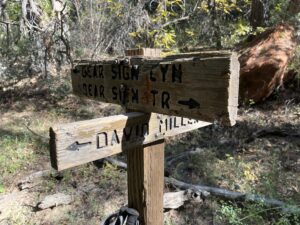In the Red Rock Secret Mountain Wilderness, there is a little used trail called Bear Sign. Exactly how it got its name is unclear, but anyone hiking it can make a pretty good guess. Recently, a Friends of the Forest volunteer was hiking Bear Sign and found that several of the trail signs had been vandalized.
Whodunit? All signs (pun intended) point to Ursus americanus, also known as the American black bear. The trail signs were marred with claw marks and puncture holes from teeth and claws. Tuffs of coarse black and brown hair were caught in the splintered wood posts and signs. Additionally, the immediate vicinity contained numerous piles of scat that have subsequently been verified as bear scat.
Al Cornell, a Friends of the Forest volunteer since the early 1990s and Friends of the Forest’s “go to guy” for all things mammal related, noted there was a similar incident about 20 years ago on Bear Sign trail. As back then, Al believes the current bear is just letting everyone know whose trail this really is.
Black bears are the most common and smallest of American bears, with females weighing an average of 125 pounds and males averaging 190 pounds. The black bear is the only bear species still found in Arizona. They can be found in all Arizona national forests and even the Grand Canyon. They live in most forest, woodland and chaparral habitats, and desert riparian areas. According to the Forest Service, they live primarily at elevations from 4,000 to 10,000 feet. The Southwest Wildlife Conservation Center estimates 2,500 black bears live in the wild in Arizona. Omnivores, eating both plant and animals, black bears primarily consume berries, nuts and insects. They are excellent climbers and swimmers and can live up to 25 years.
Janie Agyagos, Wildlife Biologist, Red Rock Ranger District, Coconino National Forest, shared information from Lee Luedeker, Arizona Game and Fish, and Scott Newth, another longtime Friends of the Forest volunteer who has studied bear behavior in North America for 30 years. Luedeker indicated that the bumper crop of acorns this year will likely lead to more bear sightings and potential encounters with humans and canines. Before the damaged Bear Trail signs were reported, Luedeker conveyed a reported bear encounter between a hiker and their off-leash dog on the Vultee Arch Trail. Based on this report, the Coconino National Forest posted their “Be Bear Aware” signs at the trailheads accessing the Red Rock Secret Mountain Wilderness trails.
Scott Newth noted, unlike grizzly and polar bears, black bears are pretty timid. Black bears tend to flee if startled and not inclined to attack, unless they are protecting their cub. If you make significant noise, black bears will typically avoid the area before you even see them. However, if a bear follows you, you should leave the area but don’t run! If a black bear does attack you should never play dead. Rather, you should make yourself as large and imposing as possible and fight back by stabbing at their eyes with a stick or hiking pole, using a rock to hit their nose, or using anything else of substance to hit them in the face and muzzle
Friends of the Forest Trail Maintenance volunteers Rod Cashin and Ernie DiMillo have already replaced the damaged signs. To see a sample of the vandal bear’s handiwork, visit the Red Rock Ranger District’s Visitor Center.
For more information on wildlife in the Red Rocks and on bears and bear safety visit the Coconino National Forest Service and Arizona Game and Fish websites.
Want more information about volunteering or Friends of the Forest? Visit www.friendsoftheforestsedona.org.
Serving Sedona, written this week by Dale Evans, Friends of the Forest, appears Wednesday in the Sedona Red Rock News.
